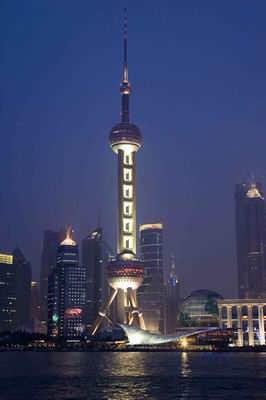Shanghai Oriental Pearl TV Tower

Overview
Shanghai Oriental Pearl TV Tower was completed on Oct. 1, 1994. It is 468 m high, being the highest in Asia and the third highest in the world, only next the TV towers in Toronto in Canada and Moscow in Russia. It stands opposite to the bund on the west bank.
Know More
The architectural modeling of the tower is unique, expressing the flavor of oriental culture.
The structure of the tower consists of 11 spheres, different in sizes and arranged at different levels, hanging from the sky down to the green lawns. It expresses the artistic concept of pearls, big and small, dropping on a jade plate.
The body of the tower is formed of two huge glittering spheres and one small delicate sphere; the sightseeing level in the upper sphere is 45 m in circumference, 263 m high, offering a bird's-eye view of the city.
In the upper sphere at the 267-m level, there is a revolving restaurant, with one revolution every hour, a disco ball, a piano accompanied bar and at the 271-m level there are 20 KTV private rooms.
The space cabin is at a level of 350 m, containing a sightseeing terrace, a meeting hall and a coffee room. Hotel in the Air is in the five smaller sphere with 20 guest rooms. The lower sphere contains a space city. There is a science fiction city inside the tower pedestal.
The Oriental Pearl TV Tower combines sightseeing, catering, shopping, recreation, accommodation, broadcasting and TV transmission into one body. It has become a symbolic architecture and a favorable spot for tourists in Shanghai.
Head back to the Oriental Pearl TV Tower and queue up for a sci-ti architectural exploration. Most vistitors will rush towards the elevators to see the city in all its expanse, chaos and splendor. However, before heading up to see what Shanghai is becoming, take some time to wander through the basement history museum. This catacomb of excellent historical displays takes you from Shanghai's early days as walled fort under the Ming dynasty to the beginning of European colonialism and up to the Japanese invasion. Several of the displays are interactive and the museum is worthy of half-day visit.














